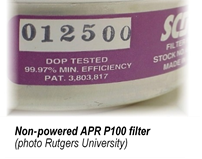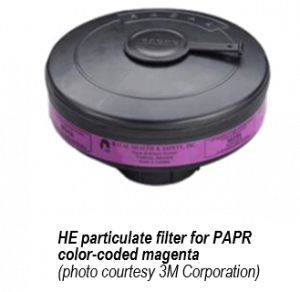For pesticides, EPA regulations [40 CFR 170.507(d)] require the replacement of particulate filters when damaged, torn, soiled, or it becomes uncomfortable for the wearer to breathe. Additionally, particulate filters should be replaced according to respirator manufacturer recommendations or pesticide labeling (whichever is more frequent).
For example, filtering facepiece respirators (FFRs) are designed by respirator manufacturers to be disposable. As pesticide loads on the FFR surface, the soiled filter can be a direct source of contamination to the respirator user and must be handled with caution. These disposables should not be used beyond a single work shift.
For non-powered air-purifying respirators (APRs), respirator manufacturers prescribe specific use limitations for particulate filters (N, R, P) since oils or oil-like substances can degrade the ability of a filter to remove particles (versus degrade the filter itself). NIOSH-approved respirator assemblies always meet or exceed certified efficiency levels (95%, 99%, 99.97%), provided that users follow recommended use instructions:
N-series filters must only be used for protection from non-oil aerosols. N-series filters must be replaced whenever damaged, soiled, or causing noticeably increased breathing resistance.
P-series filters can be used when either oil or non-oil aerosols are present. Respirator manufacturers are required by NIOSH to determine the maximum recommended service life of P-series filters when used in the presence of oil. NIOSH requires manufacturers to publish the maximum service life of P-series filters in user instructions that come with the respirator. Additional details may be found in product literature or bulletins online.
 Manufacturer replacement schedules for P-series filters in the presence of oil aerosols vary widely, from as short as 8 hours to 40 hours or more. Unless you know the manufacturer’s replacement recommendation, replace P-series particulate filters after a single work shift (up to 8 hours of continuous or intermittent use) when oil is present.
Manufacturer replacement schedules for P-series filters in the presence of oil aerosols vary widely, from as short as 8 hours to 40 hours or more. Unless you know the manufacturer’s replacement recommendation, replace P-series particulate filters after a single work shift (up to 8 hours of continuous or intermittent use) when oil is present.
When oil is not present, P-series particulate filters may be re-used if not damaged,
soiled, or causing noticeably increased breathing resistance.
For powered air-purifying respirators (PAPRs), particulate filters are rated High Efficiency (bottom right). When a PAPR with a particulate filter is required, the pesticide label will specify this by the acronym “HE.” Change PAPR filters whenever they are
damaged, torn, or soiled, or clogged. Replace PAPR HE filters when the PAPR airflow indicator shows that the minimum rated airflow cannot be maintained; see the manufacturer user guide for details. Some PAPRs are equipped with alarms when the filter(s) are clogged or blocked or battery life is low. Alarms may be audible, vibration, or flash, signaling time to exit to replace the filter(s) and/or charge batteries.
Follow respirator manufacturer instructions on service limits for APR and PAPR particulate filters as outlined above. Otherwise, replace all particulate filters at the end of the workday (up to 8 hours continuous or intermittent use). Follow state, tribal, or local regulations when they are more stringent.
R-series filters can be used when either oil or non-oil aerosols are present. When oil or oil-like substances are present, these can only be used for a single work shift (up to 8 hours of continuous or intermittent use). When oil is not present, R-series filters may only be re-used if they are not damaged, soiled, or causing noticeably increased breathing resistance.

Source: Respiratory Protection for Occupational Users of Pesticides. Patricia D. Hastings, Coordinator, Rutgers Pesticide Safety Education Program.